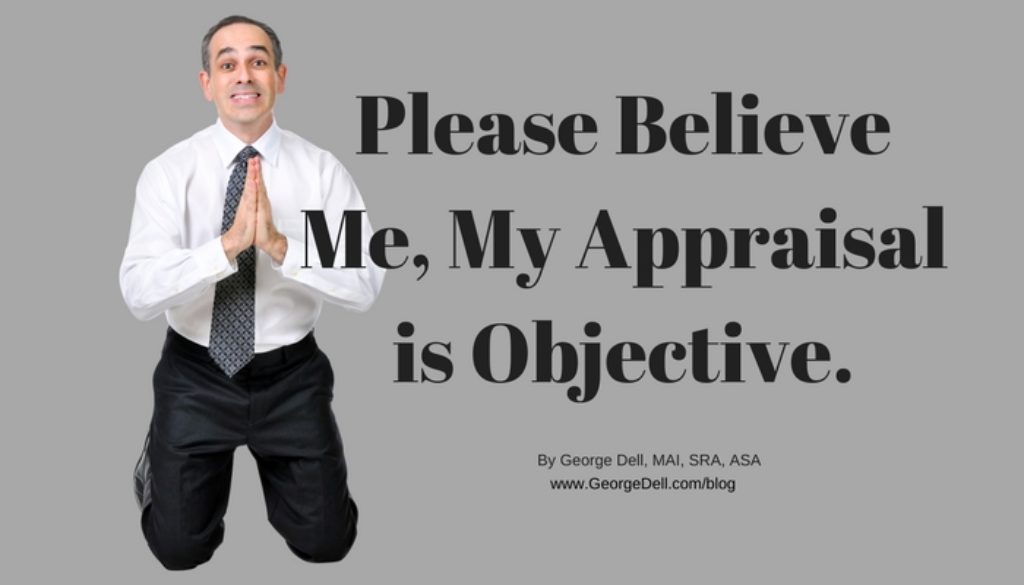Can personal opinion be objective?
The definition of “Appraiser” in USPAP requires “one who is expected to be competent, independent, impartial, and objective.”

Clearly, the definition requires delving into the mind of clients, users, and perhaps the public. Can this be true? Perhaps we can look elsewhere in USPAP for help. The definition goes on to say clients have such expectation “when individuals … represent that they comply.” So we are to believe that clients and others have that (expectation of objectivity) state of mind automatically, just because someone claims compliance. “Trust me, I am objective – because I say I am.”
Standard 1 reinforces this thought. We are required to “produce a credible appraisal.” Credible is exactly defined: “worthy of belief.”
We’re not doing well here. Let’s look elsewhere.
Ah, the Scope of Work Rule tells us when our work is acceptable. It’s ok when it “meets or exceeds”:
- The expectations of regular users; and,
- What our peers all do.
It doesn’t matter if it’s right or wrong. What matters is that it’s what clients expect, and that everyone does it. Follow the herd and its nearby cowboys. You’re safe. Hide in the dusty interior of the moving herd. Don’t challenge the cowboys. You’ll be yelled at and driven back to where you belong.
How about our reviewers? Are they cowboys? Perhaps they’re the pretty horses the cowhands ride. Do they have a saddle on their back? Who holds the reins? Who feeds them?
Let’s take a look at USPAP Standard 3. Similarly, a reviewer is also expected to “produce a credible appraisal review.” So the reviewer is expected to be believable about their judgment of believability of the appraisal. Believable believability. Oh, yeah, and if you ever review a review – be sure to be believable about your belief in the believability of the review of the believability of the appraisal. Whew!
But wait! Just one more thing.
A reviewer must also make a judgment (form an opinion) of seven things about a reviewed appraisal:
- Completeness;
- Accuracy;
- Adequacy;
- Relevance;
- Reasonableness;
- Law and regulations; and,
- User requirements.
The first three items are not found in Standard 1. However, Standard 1 states the relevant market data must be analyzed. Relevant property characteristics must be identified (including legal, physical, and economic factors). Finally, the relevance of the work done must be reconciled.
The reviewer does need to form an opinion of the reasonableness of the appraiser’s judgment – that the property characteristics, which the [appraiser] “… reasonably believes are reliable.” This same reviewer’s judgment of reasonableness extends to the appraiser’s reasonableness of an extraordinary assumption, hypothetical condition, probable modifications of land use regulations, and future income/expenses potential.
Are we clear?
Follow the law and do what your client user requires of you. Do what everyone else does. Do not stray. Stay inside the safety of the herd.
But.
There is a better way. Modern technology, combined with appraiser market competence . . . are needed. It is the intent of this blog to help improve, save, and facilitate the valuation profession. But first we need to identify what is holding us back.

April 4, 2018 @ 4:32 am
Keep up the great work, George! Yours is a voice of reason in the wilderness of USPAP ambiguity!
April 4, 2018 @ 5:42 am
I share Mr. Andersen’s thoughts! I appreciate your great work. I totally agree that it’s not always a good idea to just do what the masses are doing. Especially when it’s not supportable. Thanks for your great articles and professional leadership!
April 4, 2018 @ 6:32 am
The appraiser makes the case for a property in much the same way the attorney makes a case for the client. The rules of evidence, presentation, and logic must be followed if a credible case is to be made. One should review one’s work in the light of being cross-examined on the stand by someone who is relentless in their search for flaws in the report before submitting the appraisal. Be assured, there are reviewers who are just as particular and relentless as an attorney who must discredit the appraisal in order for his advocacy to be successful.
May 11, 2018 @ 10:19 am
An appraiser’s objectivity is his or her most valuable professional asset. I’ve had clients who have wanted me to compromise my integrity and objectivity, as I’m sure most appraisers with a significant amount of experience have, but I have never succumbed, even when it sent me into serious financial difficulties, and I’ve been much better in the long run as a result.
One of the difficulties, in addition to the ambiguity of USPAP, is the widespread misunderstanding of basic economics and, in particular, the confusion over what creates value. Value is the result of marginal utility. In layman’s terms, value derives from usefulness and scarcity and nothing else. The air we breathe is useful but is rarely scarce. A person can send an hour or a day or a week or a month or even a year producing a product or service but if it is not both useful and scarce, it has no value.
Since this economic principle was discovered by Carl Menger and William Stanley Jevons apparently independently and simultaneously in 1871, you’d think that everyone would know it by now, but apparently the Marxists, Keynesians, and even neo-classical economists haven’t figured it out, but apparently either they haven’t or they’re being intentionally dishonest.
I’m n longer doing appraisals, so I don’t claim to be objective. I’m looking out for the interests of my clients, and I make that clear to everyone I encounter. Anyone who claims to be objective should be objective. Otherwise, they are being fraudulent. I’ve fount that objectivity is not all that difficult, as long as I avoid the fog of confused economic analyses.